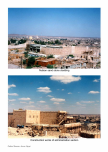Historical background
Egypt consists of five well-defined regions: the Delta, the Valley, the Eastern desert, the Western desert and Nubia.
The region called Nubia today stretches along the Nile from Aswan south to Dabba in Sudan.
The name Nubia is said to come from the ancient Egyptian ‘nbu’, which means gold, in reference to the famous gold mines of the area.
Historically, Nubia’s position as Egypt’s gateway to the rest of Africa made it an important trade centre.
The Nubian people were settlers, who lived by agriculture, trade and pastoral activities.
During the Old Kingdom, Nubia maintained its independence from Egypt but from the Middle Kingdom until the Thirteenth Dynasty it came under the domination of Egyptian kings.
The Egyptians ruled Nubia again in the Eighteenth Dynasty,
but through local governors and when the Twenty-Fifth Dynasty was established, Nubian rulers enjoyed a time of independence, political stability and economic prosperity.
Even the Roman emperors, who showed great interest in Nubia, allowed it to retain independence under their sovereignty.
By the end of the sixth century AD Nubia had converted to Christianity. In the eighth and ninth centuries, political and economic stability again brought prosperity to the region.
Nubia’s conversion to Islam occurred gradually through intermarriage with Arab traders.
Muslim leaders from Egypt sent expeditions to Nubia but it wasn’t until the sixteenth century that its conversion was complete.
Today, there is no political entity called Nubia. Its lands now lie partly in Egypt and partly in Sudan, with most of the northern region completely submerged under Lake Nasser following the building of the High Dam.
Nubian villages spread along the Nile in clustered terraces, and throughout Nubia the principal entrances to houses face the river.
The main entrance opens onto a courtyard with mastabas – raised seating areas.
The rooms of the house are arranged along the courtyard’s far wall, the most important being the mandara, or guest room, which has a separate entrance and a catenary vault roof. Some living rooms – called tents or khayma – are simply open with a flat roof of palm branches.
The houses are of mud, mud brick or stone, plastered inside and out by the women and children, who decorate the walls, especially the entrances, with bright and colourful designs.
The roofs of the houses are of palm trunks or timber beams covered with palm thatchقش النخيل . Small openings at high level help to circulate the air brought into the house via the courtyard, which acts as a ventilating space and a ‘private piece of sky’ for the benefit of the household.
Aswan is in a dry, temperate zone which enjoys a very mild climate in winter, making it a favoured winter resort since the beginning of the nineteenth century. It rarely rains, although torrential downpours occur every four or five years. The prevailing winds are from the northeast.
Sandstorms come from the west during spring but last only a couple of days.
In winter the temperature ranges from a maximum of 26˚C to a minimum of 10˚C, with a humidity maximum of 56 per cent. In the summer months the temperature can reach 42˚C, becoming mild at night at a minimum of 26˚C. The humidity in May goes down to 7 per cent.




















No comments:
Post a Comment